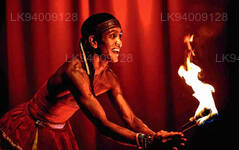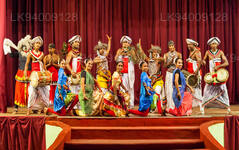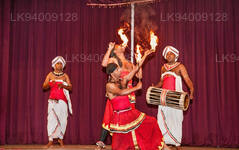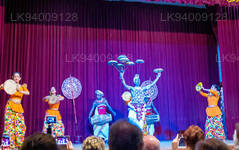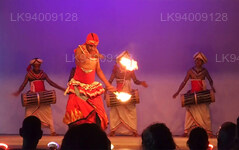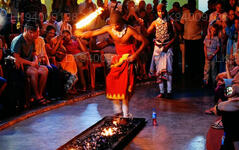
Kandy, pittoresca città dello Sri Lanka centrale, è rinomata per il suo ricco patrimonio culturale, i vivaci festival e la bellezza paesaggistica. Immersa tra lussureggianti colline, ospita il Tempio della Reliquia del Dente di Buddha, patrimonio mondiale dell'UNESCO, e offre un'affascinante combinazione di storia e splendore naturale.
Kandy, pittoresca città dello Sri Lanka centrale, è rinomata per il suo ricco patrimonio culturale, i vivaci festival e la bellezza paesaggistica. Immersa tra lussureggianti colline, ospita il Tempio della Reliquia del Dente di Buddha, patrimonio mondiale dell'UNESCO, e offre un'affascinante combinazione di storia e splendore naturale.
Kandy Cultural Show
The Kandy Lake Club Cultural Dance Show is a stimulating Sri Lankan Arts, Dance & Cultural Heritage Show that is a must see for any visitor who visits the historic city of Kandy. The Kandy Lake Club Dance started in 1982 with the view of having a cultural dance performance bringing together all Sri Lankan dance types to one platform. It is the first Cultural Dance Show of its kind to be established in Sri Lanka. It has since become a tourist attraction for many people visiting the country and keen on a glimpse of its rich cultural heritage. Hence it has been performing continuously for the last 35 years. Dance techniques unique to areas of the island are usually passed on from generation to generation. These Dances are performed at local ceremonies and rituals using drums and costumes that are unique to each area. Among the attractions are the Dances depicting the majestic walk of the elephant, colourful performance of the peacock and the mystical movements of the cobra. There are also dances with traditional masks, traditional drums and flames. The show ends with the unbelievable feat of walking on red-hot charcoal, which is a traditional form of worship of local gods. Right throughout the show you can enjoy the sounds of drums and other traditional musical instruments of Sri Lanka.  A hand out in different languages gives our customers a description of every item with all interesting facts and features of the dance show.
The Kandy Lake Club Cultural Dance Show is a stimulating Sri Lankan Arts, Dance & Cultural Heritage Show that is a must see for any visitor who visits the historic city of Kandy. The Kandy Lake Club Dance started in 1982 with the view of having a cultural dance performance bringing together all Sri Lankan dance types to one platform. It is the first Cultural Dance Show of its kind to be established in Sri Lanka. It has since become a tourist attraction for many people visiting the country and keen on a glimpse of its rich cultural heritage. Hence it has been performing continuously for the last 35 years.
- Magul Bera: The blowing of the Conch Shell is the traditional invocation at the commencement of any function and the drums are an integral part of the ritual. It is an ancient Sinhala custom to present ritual music when seeking the blessings of the Guardian of the land.
- Puja Natuma: The female dancers carrying oil lamps are making an offering of their dancing skills to the Guardian Deities.
- Devol Natuma: A dance sequence performed for general immunity from evil influences as well as for healing specific ailments. It is a part of a ceremony connected with folk believes. The vigorous movements of the dancers are derived from the dance forms of the Southern parts of Sri Lanka.
- Mayura Natuma:The female dancers depict the graceful movements of the peacock which according to mythology is the bird that transports Skanda, the War-God of Ceylon, worshipped by Buddhists and Hindus alike.
- Pantheru Natuma: The name of the dance is derived from the musical instrument used, the pantheru, which is close akin to the tambourine. Rhythm is also provided by the accompanying drums. The dance itself shows Sinhala warriors on their way to battle.
- Raksha Natuma: A South Sri Lanka mask dance with the raksha masks symbolising the fight between a cobra and a bird. This dance is used to exorcise demons from the possessed and is still believed to be effective psychiatric treatment in Sri Lanka.
- Lee Keli Natuma: A dance popular in the all parts of the country, particularly during festivals in which both male and female dancers participate. Each dancer has two sticks and the sound of the sticks striking each other together with those of the accompanying drums provide the rhythm for the dancers.
- Raban Natuma: A traditional folk dance which uses the Rabana, an instrument similar to the drum. The popular Ath Rabana (hand Rabana) is almost one foot in diameter and is both played and wielded in a variety of forms by the male and female dancers. Raban playing is accompanied by singing too.
- Gini Sisila: A south Ceylon fire dance showing the power of charms over fire and the twenty seven devils that can trouble mankind. The absolute faith of the fire dancers protects them from the flames. This dance also includes fire-eating.
- Ves Natuma: This dance is the one of the most important forms of Kandyan dance. Ves is the traditional attire of the Kandyan dancer. Sixty four ornaments complete the dress and traditionally their sheen symbolizes the rays of the sun. It takes years of rigorous training before a dancer can achieve the status of a fully-fledged ves dancer.
- Kulu Natuma: A traditional folk dance performed by village damsels to celebrate a rich harvest. The dance portrays sequences from reaping to winnowing of the grain. This is a buoyant dance providing ample opportunities for displaying feminine grace. It is performed to the accompaniment of light drum beats and the haunting strains of the flute.
- Fire walking: The origin of fire walking can be traced back to the epic story of Rama and Sita. Ravana, the King of Ceylon, had abducted the princess of India, Sita. When Rama her husband (an Indian King) regained her, she proved her chastity during her enforced stay with Ravana, by walking on fire, barefoot and unhurt. The devotees who perform fire-walking seek the divine blessings of Lord Kataragama and Goddess Pattini before they do so.
During the show, you will see several dances which depict the graceful movements of birds and animals, which trace their origins back to the ancient ritual known as the Kohomba Kapkariya, as well as energetic acrobatic performances where the men perform a series of leaping pirouettes and stunts such as plate-spinning and the dramatic ‘fire walk’ which ends the show.
Informazioni sul distretto di Kandy
Il distretto di Kandy si trova nella provincia centrale dello Sri Lanka. Uno dei sette siti Patrimonio dell'Umanità dello Sri Lanka, Kandy un tempo era la dimora dei re di Kandy nel XVI secolo e una fonte di tutta la musica, l'arte, l'artigianato e la cultura del paese. A circa 129 km da Colombo, Kandy è incastonata in un terreno collinare e tutti gli occhi sono attratti dal centro della città, dove il lago di Kandy costituisce un elemento affascinante. Kandy conserva un grande significato religioso per lo Sri Lanka, perché è in questa affascinante città che si trova il Dalada Maligawa o "Tempio del Dente", all'interno del quale giace ben custodita la sacra reliquia del dente del Signore Buddha. Il Giardino Botanico Reale di Peradeniya si trova a circa 5 km a ovest del centro città a Peradeniya ed è visitato da 1,2 milioni di persone all'anno. È il più grande giardino botanico dell'isola. L'Udawatta Kele (Foresta di Udawatta) è un santuario protetto situato nel cuore della città, appena a nord del Tempio del Dente. Kandy è una città a maggioranza singalese; vi sono comunità consistenti appartenenti ad altri gruppi etnici, come Mori e Tamil. Kandy è seconda solo a Colombo, il centro dell'economia dello Sri Lanka. Molte importanti cooperative hanno grandi filiali a Kandy e molte industrie, tra cui tessile, arredamento, informatica e gioielleria, si trovano qui. Molti centri di ricerca agricola si trovano in città. È una fonte di tutta la musica, l'arte, l'artigianato e la cultura del paese. A circa 129 km da Colombo, Kandy è immersa in un terreno collinare e tutti gli occhi sono attratti dal centro della città, dove il Lago di Kandy costituisce un elemento incantevole. Kandy conserva un grande significato religioso per lo Sri Lanka, perché è in questa affascinante città che si trova il Dalada Maligawa o Tempio del Dente, all'interno del quale è ben custodita la sacra reliquia del dente del Signore Buddha.
Informazioni sulla provincia centrale
La Provincia Centrale dello Sri Lanka è costituita principalmente da un territorio montuoso. La provincia ha una superficie di 5.674 km² e una popolazione di 2.421.148 abitanti. Alcune delle città principali includono Kandy, Gampola (24.730), Nuwara Eliya e Bandarawela. La popolazione è un mix di cingalesi, tamil e mori. Sia la capitale collinare Kandy che la città di Nuwara Eliya si trovano nella Provincia Centrale, così come Sri Pada. La provincia produce gran parte del famoso tè di Ceylon, piantato dagli inglesi negli anni '60 dell'Ottocento dopo che una devastante malattia distrusse tutte le piantagioni di caffè della provincia. La Provincia Centrale attrae molti turisti, con città collinari come Kandy, Gampola, Hatton e Nuwara Eliya. Il Tempio del Dente o Dalada Maligawa è il principale luogo sacro della provincia di Central. Il clima è fresco e molte zone intorno ai 1500 metri hanno spesso notti fredde. I pendii occidentali sono molto umidi, con precipitazioni che in alcuni punti raggiungono quasi i 7000 mm all'anno. I pendii orientali appartengono alla zona medio-secca, in quanto ricevono pioggia solo dal monsone di nord-est. Le temperature variano dai 24 °C di Kandy ai soli 16 °C di Nuwara Eliya, che si trova a 1.889 m sul livello del mare. Le montagne più alte dello Sri Lanka si trovano nella Provincia Centrale. Il territorio è prevalentemente montuoso, con profonde valli che lo attraversano. Le due principali regioni montuose sono il massiccio centrale e la catena delle Knuckles, a est di Kandy.

